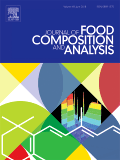Breeding efforts to develop high iron and zinc potatoes require a fast and inexpensive technique to evaluate mineral concentrations in large numbers of samples. In this study, we evaluated the feasibility of applying X-ray fluorescence spectrometry to estimate iron and zinc in freeze-dried and milled potato tuber samples. The calibration, and the external and independent validations showed high coefficients of determination, 0.93–0.96 for iron and 0.92–0.97 for zinc, and low standard errors, 1.10–1.44 mg/kg DW for iron and 0.91–1.06 mg/kg DW for zinc concentrations, indicating that iron and zinc can be estimated by X-ray fluorescence spectrometry with high precision. The developed calibrations were applied to estimate iron and zinc concentrations of hundreds of biofortified potato clones from the International Potato Center’s breeding program, grown in 3 distinct locations of Peru. Twenty clones showing high iron concentration (above 32 mg/kg DW) and 13 clones with high concentration of zinc (above 25 mg/kg DW) were identified. X-ray fluorescence spectrometry provides a rapid, low cost and suitable tool for potato breeders, compared to inductively coupled plasma optical emission spectrometry for screening iron and zinc concentrations, especially when a high number of potato clones must be evaluated in a short time frame.
Potential and application of X-ray fluorescence spectrometry to estimate iron and zinc concentration in potato tubers
Citation: Sosa, P.; Guild, G.; Burgos, G.; Bonierbale, M.; Felde, T.zum. 2018. Potential and application of X-ray fluorescence spectrometry to estimate iron and zinc concentration in potato tubers. Journal of Food Composition and Analysis. (USA). ISSN 0889-1575. 70:22-27.
2018-04-23
BREEDING, FOOD SYSTEMS, POTATO AGRI-FOOD SYSTEMS, POTATOES
journal_article

